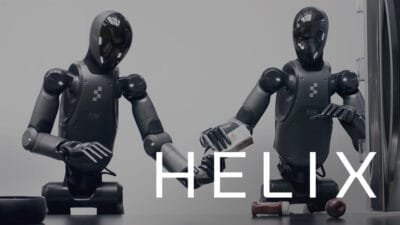The UK-based startup Humanoid has entered the global robotics arena with its groundbreaking HMND 01, a next-generation humanoid robot designed for industrial automation and mass commercialization.
Launched in February 2025, this robot combines advanced AI, modular hardware, and cost-effective design to address workforce shortages and aging populations while enhancing productivity.

Key Features of HMND 01
- Human-Centric Design:
- Height/Weight: 175 cm (5’9”), 70 kg (154 lbs) – mirroring average human proportions for seamless integration into existing environments.
- Payload & Speed: Lifts 15 kg (33 lbs) and walks at 1.5 m/s (5.4 km/h), comparable to human workers.
- Runtime: Operates for 4 hours on a single charge, ideal for shift-based tasks.
- Cutting-Edge Technology:
- 41 Degrees of Freedom: Enables human-like dexterity for complex tasks like object manipulation and navigation in confined spaces.
- Modular Architecture: Customizable upper/lower body and end-effectors (e.g., grippers) to reduce costs and adapt to industries like retail, logistics, and manufacturing.
- AI Integration: Proprietary algorithms for environment perception, locomotion control, and real-time decision-making.
- Commercial Viability:
- Low Total Cost of Ownership (TCO): Industrial-grade durability minimizes maintenance, making it suitable for mass deployment.
- Interchangeable Garments: Protects hardware and allows role-specific customization (e.g., sterile covers for healthcare).
Founder Vision: Artem Sokolov emphasizes HMND 01’s role in fostering “human-robot harmony,” tackling labor shortages, and freeing humans for creative work.
HMND 01 vs. Tesla Optimus: A Head-to-Head Comparison
While Tesla’s Optimus Gen 2 (announced in late 2024) aims to dominate the consumer and industrial markets, HMND 01 carves a niche with modularity and affordability. Below is a detailed comparison:
| Feature | HMND 01 | Tesla Optimus Gen 2 |
|---|---|---|
| Height | 175 cm (5’9”) | ~173 cm (5’8”) |
| Weight | 70 kg (154 lbs) | ~73 kg (161 lbs) |
| Payload Capacity | 15 kg (33 lbs) | 20 kg (44 lbs) |
| Walking Speed | 1.5 m/s (5.4 km/h) | 1.3 m/s (4.7 km/h) |
| Battery Runtime | 4 hours | 6-8 hours (estimated) |
| Degrees of Freedom | 41 | 35 (Gen 1) / 40+ (Gen 2 projected) |
| AI & Learning | End-to-end AI for manipulation & locomotion | Neural networks (AI5 chip) for autonomous tasks |
| Key Innovation | Modular hardware for cost reduction | Tesla FSD (Full Self-Driving) integration |
| Target Applications | Warehouses, retail, logistics | Manufacturing, domestic assistance |
| Price & Availability | Not disclosed (focused on TCO) | ~$50,000 (projected for 2027) |
| Release Status | Alpha testing (2025) | Prototype testing (2025), mass production by 2027 |
Why HMND 01 Stands Out
- Modularity Over Monolithic Design: Unlike Optimus’s fixed architecture, HMND 01’s swappable components allow businesses to tailor hardware for specific tasks, reducing upfront costs.
- Focus on Industrial Use Cases: While Tesla targets broader consumer applications, HMND 01 prioritizes logistics and manufacturing, addressing immediate automation gaps.
- Cost Efficiency: Humanoid’s emphasis on low TCO makes it accessible for SMEs, whereas Optimus’s premium pricing aligns with Tesla’s high-tech branding.
The Road Ahead
Humanoid’s HMND 01 and Tesla’s Optimus represent two visions of the future: one hyper-focused on industrial adaptability, the other on scalable consumer robotics. While Tesla leverages its AI expertise, Humanoid’s modular approach could disrupt markets where customization and affordability are paramount. As both platforms evolve, 2025–2027 will be pivotal in determining which philosophy shapes the next decade of automation.





